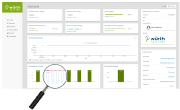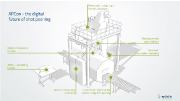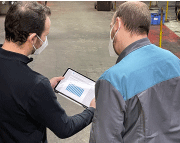E-Archive
Articles
in Vol. 23 - January Issue - Year 2022
Complete Verification Procedure For Residual Compressive Stresses With Shot Peening 4.0

Via an online platform, parameters such as the degree of use of the system or abrasive and energy consumption are accessible on different end devices such as a computer, smart phone or tablet

Typical set-up of an APCon system on a wheel blasting machine

A project manager from Würth Solutions discusses the performance status of the blasting system together with the user. Via web access, all end devices such as PCs, smartphones, etc., can be connected on a flexible basis.
Out of necessity, an abrasives manufacturer developed the first indirect method of verification for residual compressive stresses in fatigue-resistant components to have been integrated in the blasting machine
The original 2015 goal of the abrasives manufacturer Eisenwerk Würth was to develop a piece of technical equipment allowing for the consumption of abrasives to be measured on blasting wheel systems. With the support of data and figures, the aim was to verify the reduced use of the blasting abrasives to the customers, as experience had shown that handwritten records were very inaccurate, and purchasing decisions were often made on a subjective basis.
Following from this idea, the concept of a holistic process monitoring system for the blasting process was developed within a few weeks, which resulted in a first patent as soon as the year 2016. The system has now developed further and is being used successfully on the market with the name APCon (Abrasive Process Control). Along the lines of a start-up, a separate company division, “Würth Solutions”, was founded for the development and distribution of this system, which offers various supplementary services and technical advice in addition to the APCon system.
What APCon does
The system consists of various sensors fitted to the blasting wheel system that monitor and document the key process parameters on a digital basis. These parameters are prepared and displayed for the user on a permanent basis via an interactive platform. The available sensors, such as Magna Valves, can be integrated into the system easily, whereby the throughputs can also be displayed as a diagram with precise timing and used retrospectively to provide verification.
The development was based on the principle of the “digital twin”, which allows the interrelationships between the individual process parameters to be displayed and evaluated. For example, the extraction speed from the air separation by the blast machine can be monitored and compared with the use of the abrasives and the resulting composition of the abrasives to verifiably ensure a consistently high kinetic energy transmission by the abrasive to the surfaces that are to be shot-peened.
To demonstrate a reproducible, stable shot peening process, the software has various tools with which, for example, maintenance, Almen intensity measurements, the screening of abrasives or actual measurements of the residual compressive stress are stored on a temporally-accurate basis. On this basis, the possible target values within which the process parameters are able to move are rapidly determined and can be stored as limit values. If these limit values are crossed, a message is immediately sent to the employee who is responsible for the process, allowing countermeasures to be initiated directly.
The development continues
The APCon system is currently being further developed to supplement the possible countermeasures on the basis of targeted proposals with the use of “artificial intelligence”.
In the future, trend monitoring and the comparison of parameter constellations will also allow for forecasts whereby the system will be activated before limit values are crossed and narrow down possible causes of faults on a precise basis so as to avoid unnecessary operational downtimes or insufficiently blasted parts.
In blasting systems without the use of shot peening, the system is not primarily used as an indirect verification procedure, but serves to optimise the blasting process and the subsequent additional processing steps. By comparing the various process parameters on a systematic basis, the mutual dependencies of the parameters become very clear and provide the basis for targeted optimisations. If a parameter is consciously changed, the impact on the process and the blasting results can be seen on the basis of facts and figures. On many of the blast machines equipped with APCon, for example, a reduction in the abrasive throughput has been achieved without having a negative impact on the blasting result. Optimisations often result in potential savings in the areas of energy, system maintenance, the use of abrasives and the blasting time, which amount to > 10% of the total annual processing costs. Due to the reproducible operation of the system, which is made possible by APCon, savings are achieved on a permanent basis over a long period of time, improving the TCO (total cost of ownership) on a verifiable and sustainable basis.
In most cases, the use of APCon therefore pays for itself within the first two years ...
Key Account Manage Industry 4.0
Würth Solutions, Eisenwerk Würth GmbH
Tel. +49.7136.9898-0
E-mail: miller@eisenwerk-wuerth.de
www.wuerth-solutions.de



























